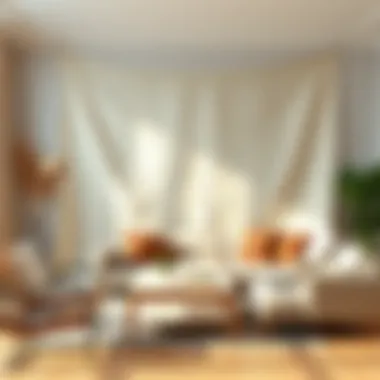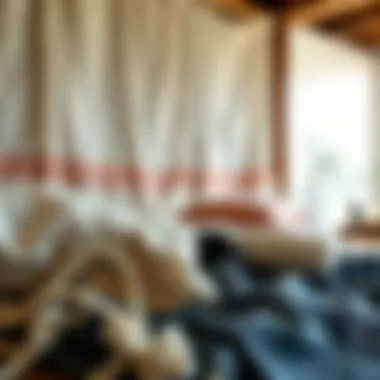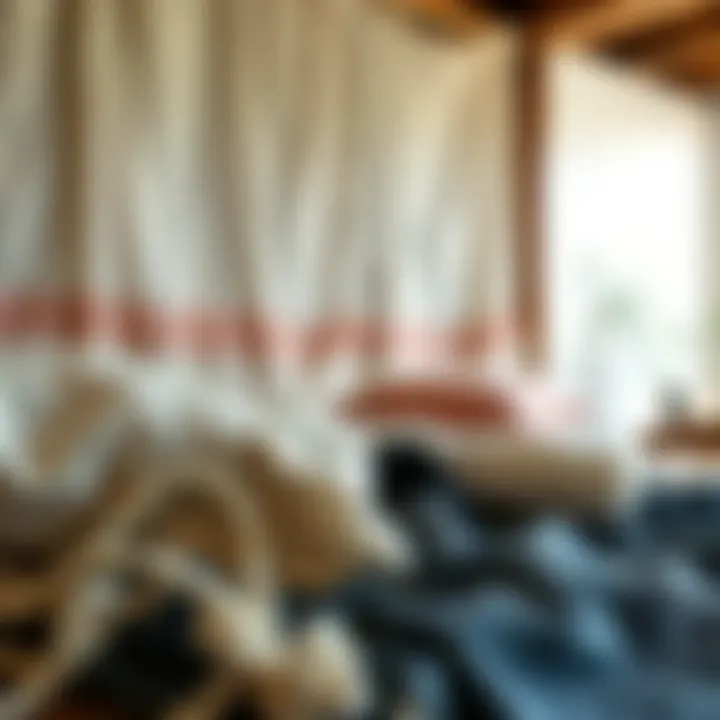The Art of Linen Tapestry for Unique Wall Decor


Intro
Linen tapestry has stood the test of time, evolving not just as an art form, but as a significant aspect of home decoration. This intricate craft weaves stories into fabric, transforming plain walls into vibrant narratives. As a timeless element, linen tapestry serves both aesthetic and functional purposes, bringing warmth and character to interior spaces.
Historically, tapestries were considered status symbols in grand homes, showcasing wealth and artistry. Today, these textile wonders have made a resurgence, aligning with contemporary tastes and sustainability values. Whether it’s about preserving heritage or expressing modern flair, linen tapestry appeals to diverse design sensibilities.
In the following sections, we’ll navigate the rich tapestry of styles and variations, maintenance practices for longevity, and even the best placements to enhance your decor. For those who are mindful of their ecological footprint, we’ll explore sustainable practices in the tapestry-making industry as well. Together, we will discover how to elevate your living spaces with this exquisite craft, ensuring your home reflects creativity and responsible artistry.
Prelude to Linen Tapestry
Linen tapestry represents more than just a decorative piece; it's a canvas woven with history, heritage, and artistry. In recent years, there’s been a resurgence in the appreciation for textiles in home decor, and linen tapestries have stood out as a timeless option that speaks volumes about a space's character.
In this article, we’ll uncover what makes linen tapestry so special. For one, linen as a material brings durability and elegance together, allowing for intricate designs that add depth to any room. The rich textures and earthy tones of linen can effortlessly enhance both modern and traditional interiors.
Considerations also emerge regarding the crafting process of linen tapestry, which often reflects cultural significance and unique artistry. The way these tapestries are placed can transform a drab wall into a focal point that ignites conversation.
Definition and Characteristics
To fully grasp the allure of linen tapestry, we need to define it clearly. A linen tapestry is essentially a decorative textile made from linen fibers, often depicting artistic designs or storytelling motifs. Unlike standard fabric, the unique weave of linen creates a textured surface that enhances visual interest and durability.
Linen has a natural luster that catches light differently compared to other fabrics, offering a rich array of colors, from soft neutrals to bold shades. Some characteristics include:
- Breathability: Unlike synthetic fabrics, linen allows air circulation, making it less prone to humidity-induced damage.
- Sustainability: Linen is made from flax, which is generally more eco-friendly compared to cotton or synthetic materials.
- Aging Beautifully: As linen tapestries age, they develop a soft patina that adds to their charm and character.
Historical Overview
The history of linen tapestry can be traced back to ancient civilizations, where it served not merely as decor but as a narrative medium. Early examples emerged from regions like Egypt and Mesopotamia, where artisans created intricate woven works that depicted events, myths, and cultural stories. Unlike today’s machine-made alternatives, these ancient tapestries were painstakingly crafted by hand, showcasing remarkable skill and artistry.
In medieval Europe, linen tapestry transitioned into a symbol of wealth and status. Noble families adorned their castles and homes with detailed narrations of their lineage or victories in battles. This usage not only communicated prestige but also reflected the artistry and craftsmanship prevalent at the time.
Today, the revival of interest in textile arts has brought linen tapestry back into contemporary decor. Merging historic techniques with modern designs, today’s artisans cleverly blend traditional motifs with contemporary art, ensuring that this age-old craft continues to captivate.
"Linen tapestry is not just woven art; it’s an expression of identity and heritage, textile legacies passed down through generations."
In closing, the exploration of linen tapestry goes far beyond mere wall decor. It's an invitation to connect with history, appreciate artistry, and elevate personal spaces through thoughtful aesthetic choices.
Linen as a Material
Linen has long stood out as a distinguished fabric in the tapestry world, embodying a blend of durability and elegance that is hard to match. This section will discuss the significance of linen as a primary material in tapestry production, particularly its fabric benefits and how it compares to other materials typically used in textile art.
Benefits of Using Linen
Linen's reputation as a top-tier choice for tapestry making arises from various beneficial attributes. First and foremost, linen fibers are naturally strong and resilient. This allows linen tapestries to withstand the test of time, maintaining their structural integrity even under the weight of artistry.
- Breathability: Linen excels in moisture absorption, allowing it to breathe, which is essential for indoor air quality. This property contributes to a comfortable atmosphere in the home.
- Eco-Friendly Nature: Given that linen is derived from the flax plant, it is considered a more sustainable option compared to synthetic fibers. The production of linen requires fewer chemicals and less water, making it an environmentally responsible choice for conscious consumers.
- Natural Texture: The texture of linen is a charming blend of softness and ruggedness. It possesses a unique luster that catches the light in ways that synthetic materials simply cannot, enhancing the visual appeal of a tapestry.
- Thermal Regulation: Linen has excellent insulating properties, keeping spaces warm in the winter and cool in the summer, thus making linen tapestries a versatile addition to any decor.
In essence, linen brings a level of authenticity and warmth to tapestry art that resonates with both modern and traditional aesthetics alike.
Comparing Linen to Other Fabrics
When evaluating linen against popular alternatives such as cotton or polyester, its virtues become more pronounced.
Cotton vs. Linen:
While cotton is widely favored for its softness, it lacks the structural durability of linen. Cotton tapestries can sag and lose form over time, especially if subjected to humidity. Linen, in contrast, retains its shape and remains taut even in challenging environments.
Polyester vs. Linen:
Polyester might boast durability, but often at the cost of breathability and texture. Polyester fabrics are prone to fading and can feel synthetic, while linen's organic fibers promote a more natural and textured finish. Moreover, the lack of environmental sustainability in polyester production raises significant concerns for today's conscientious consumers.
Thus, linen holds a distinct position in the tapestry arena due to its unique blend of strength, aesthetics, and environmental responsibility. It has become the fabric of choice for those looking to make a statement in their living spaces while ensuring quality and sustainability.
"Linen is not just a fabric; it is a testament to craftsmanship and a commitment to sustainability."
The Artistic Value of Linen Tapestry
Linen tapestry is more than just a decorative element on walls; it embodies an intricate interplay of artistry, history, and emotion. Understanding the artistic value of linen tapestry unlocks its potential to elevate interiors in ways that go beyond mere aesthetics. It showcases craftsmanship and cultural significance, allowing those who appreciate it to connect deeply with their spaces.
Tapestry Techniques and Styles


The world of linen tapestry is vast, prevalent with a variety of techniques and styles that speak to the craft's rich heritage. Notably, weaving techniques differ significantly, ranging from the traditional methods that have stood the test of time to more modern interpretations that embrace innovation.
- Weaving Techniques: Different weaving styles bring unique textures and patterns to life. For instance, the Gobelin technique, with its intricate details and dense threading, brings images to life in a way that captivates and engages viewers. Conversely, the Jacquard method, known for its use of looms with programmable patterns, allows for highly complex designs to be produced, making it a favorite among contemporary artisans.
- Styles: Styles can vary from the opulent Baroque tapestries, which often depict historical or mythological themes, to simplistic, minimalist designs that charm through their understated elegance. This diversity means there's a linen tapestry style to suit every taste and decor scheme.
Exploring these different techniques not only enhances appreciation for the artistry involved but also guides individuals toward selecting tapestries that resonate with their personal aesthetic. Choosing the right style and technique can transform a space from bland to breathtaking.
Symbolism in Tapestry Art
Tapestries often carry significant meanings intertwined with historical and cultural contexts. The symbolism found within various designs can speak to values, beliefs, and even local myths, turning a simple piece of fabric into a storytelling medium.
- Nature and Life: Many linen tapestries feature motifs from nature—floral patterns, animals, and celestial bodies—that signify growth, life cycles, and the interconnectedness of all living things. Such depictions often serve as reminders of beauty and harmony within nature, encouraging observers to reflect on their own existence.
- Cultural Narratives: Beyond personal significance, these tapestries often include elements significant to specific cultures or periods in history. For example, medieval tapestries depicted scenes of daily life or historical events, serving both decorative and educational purposes. They acted as visual narratives that documented the values and struggles of their time.
Tapestry is not just art; it’s a visual language that speaks across generations, encapsulating the ideals and dreams of those who came before us.
Modern Applications of Linen Tapestry
Linen tapestry is not just a relic of the past; it’s becoming a vibrant part of modern home decor. As people seek to create personalized and aesthetically pleasing environments, linen tapestry serves as a unique medium that embodies both artistry and functionality. Its applications in contemporary settings highlight its versatility and the myriad of benefits it offers. In an age where interior design trends evolve rapidly, embracing linen tapestry can elevate spaces beyond mere decoration.
Home Decor Trends
In recent years, there has been a noticeable shift towards natural materials in home design. Linen, with its organic texture and neutral tones, aligns perfectly with the movement towards minimizing synthetic elements in interiors.
When exploring home decor trends, linen tapestry can fit seamlessly into various design philosophies. For example:
- Scandinavian Minimalism: Here, simplicity reigns supreme. A single linen tapestry featuring soft, muted colors can become an understated focal point on a white wall, creating a peaceful ambiance without overwhelming the space.
- Bohemian Style: This trend celebrates vibrant patterns and eclectic combinations. A bold linen tapestry peppered with colors and designs can bring a playful energy to a room, mixing and matching with other textiles for a casually arranged feel.
- Modern Farmhouse: The rustic charm of linen complements the homey appeal of farmhouse style. Linen tapestries can add warmth and texture to spaces dominated by wood and neutral colors, providing a soft counterbalance that feels inviting and cozy.
- Industrial Decor: Tapestries can also bring softness to the hard edges of industrial design. Large, dramatic linen pieces add a layer of comfort while maintaining an edgy look that embraces the coarseness of urbanized environments.
Incorporating Tapestry into Various Spaces
Adding linen tapestry to different areas of your home can transform each room into a sanctuary of style and comfort. Let’s take a look at how one might thoughtfully incorporate these textiles:
- Living Room: Consider creating a striking feature wall with a large linen tapestry that draws the eye. This can serve as an artistic centerpiece, harmonizing with sofas and coffee tables while inviting conversation.
- Bedroom: In bedrooms, linen tapestries can be used as headboards, infusing a sense of tranquility through soft textures and hues. A calming landscape or abstract design can enhance relaxation and set a serene mood.
- Home Office: In workspaces, these tapestries add a unique touch that cultivates creativity. Opt for designs that inspire or motivate; a bold geometric pattern can energize a sterile environment, making work feel less mundane.
- Hallways: Utilizing tapestries in narrow spaces can color the often overlooked corridors. An elongated piece can elongate the line of sight, making these transitional spaces more visually interesting.
Closure
The modern applications of linen tapestry are practically limitless. Through mindful integration into various home styles and spaces, these pieces not only represent art but also reflect personal stories and preferences. As we increasingly value individuality in decor, linen tapestry stands out as a timeless choice that bridges the gap between traditional craftsmanship and contemporary aesthetics.
"Decorating with linen tapestry allows for a conversation between the fabric of history and the threads of modern life, weaving a narrative that is both personal and aesthetically compelling."
For further insights on decorating with textiles, consider exploring resources like Britannica or forums on Reddit. Stay inspired and informed as you venture into the artistry of linen tapestry.
Selecting the Right Tapestry
Choosing a tapestry might seem straightforward, but it’s a nuanced endeavor that involves a tune-up of myriad factors. Selecting the right tapestry not only enhances the aesthetic appeal of a room but also ensures that it resonates with your personal style and complements the surrounding decor. The depth of a tapestry's impact on a space cannot be overstated. It’s like finding a piece of jigsaw that completes the puzzle of your interior design aspirations. Let’s dive into the subtleties that make this selection process vital.
Choosing Size and Scale
When it comes to linen tapestry, size and scale are paramount. A tapestry that’s too small can get swallowed by a vast wall, while one that’s oversized can loom oppressively, making the space feel cramped. The trick is to strike a balance. Here are some key pointers:
- Wall Dimensions: Start by measuring your wall space. Aim for a tapestry that covers about two-thirds of the wall to create a harmonious focal point.
- Room Functionality: Consider the purpose of the room. A dense tapestry in a cozy study might promote warmth, while a lighter piece in a bright hallway could evoke a sense of openness.
- Furniture Layout: Ensure your tapestry complements existing furniture. For instance, a tapestry above a sofa should ideally stop a few inches above the backrest to create a cohesive look without overwhelming the eye.
Choosing the right size isn't merely aesthetics; it creates a rhythm in the space, guiding the eye and providing visual interest. Remember that art should elevate a room's presence without demanding all the attention.
Color Palettes and Patterns
Color is the backbone of any tapestry. It has the power to set a mood, evoke emotions, and anchor your decor. When selecting a color palette for your linen tapestry, consider the following:
- Complementing the Existing Palette: Choose colors that resonate with the hues already present in the room. A tapestry featuring warm tones can harmonize beautifully with wooden accents, while cooler shades might align better with modern designs.
- Patterns vs. Solids: Remember that intricate patterns bring dynamism while solid colors offer simplicity. A bold patterned tapestry can serve as a statement piece, while a solid piece can work as a subtle backing for other decor elements.
- Mood and Ambiance: Different colors evoke different feelings. For example, warm oranges and reds can foster warmth and energy, whereas blues and greens might bring a sense of calm and relaxation.
Being mindful of these considerations ensures that when guests step into your space, they’re not merely observing decor but experiencing the atmosphere you’ve intentionally crafted. Choosing an appropriate tapestry becomes an act of storytelling, where every detail contributes to a larger narrative.
Displaying Linen Tapestry
Displaying linen tapestry is not just about showcasing a piece of art; it’s about how this fabric-based craftsmanship enhances the ambiance of a space. When thoughtfully positioned, linen tapestries can act as focal points or complementary accents that breathe life into otherwise dull walls. There’s an artistry in the way they can transform a room's character. The vivid displays not only express individual style but also provide a tactile element that engages visually and physically.
When integrating linen tapestries into a decor scheme, one must consider the overall aesthetic of the room, including colors, themes, and existing furnishings. Simply hanging a tapestry without regard for these elements can leave the decor feeling disjointed. To maximize the impact, it's essential to pay attention to the tapestry's design, placement, and how it converses with the surrounding decor.


Mounting Techniques
Choosing the right mounting technique for linen tapestries can greatly affect their presentation. Opting for traditional wooden dowels or decorative rods can lend a classic appearance, while sleek metal brackets may contribute a modern touch. Each method has its own benefits:
- Dowel Rods: Often made from wood, these can add warmth to the decor. They are simple to use and can be painted or stained to match the tapestry and wall colors.
- Clips and Hooks: These allow for easy hanging and removal, which is great for those who like to change their decor frequently.
- Stretch Frames: They offer a taut presentation, ensuring that the tapestry maintains its shape and visual integrity over time.
Selecting a method that complements the tapestry's style while ensuring it is securely attached to the wall is crucial. The last thing you want is for your beautiful artwork to come crashing down, leaving a mark far worse than any decor choice could.
Creating a Gallery Wall
A gallery wall featuring linen tapestries can serve as a stunning statement. This approach allows for a dynamic collection of art to tell a collective story while showcasing varied designs and colors. Here are some ways to effectively curate a gallery wall:
- Mix and Match Sizes: Incorporate tapestries of differing dimensions to create visual interest. Larger pieces can anchor the arrangement, while smaller tapestries can fill in the gaps and add depth.
- Color Cohesion: While variety is key, maintaining a color theme helps to unify the display. Coordinate the tapestry colors with existing wall hues or other decor elements to create harmony.
- Layering Techniques: Consider layering textiles with framed prints or other types of art. The textural contrast can elevate the overall look, making the wall feel more inviting and less one-dimensional.
- Strategic Placement: Ensure the tapestry heights are at eye level for the best viewing experience. This not only makes the pieces accessible but also encourages admiration.
When done correctly, a gallery wall isn’t simply a collection; it’s a narrative thread weaving through individual histories and aesthetic choices, each tapestry revealing a layer of who we are as decorators.
Caring for Linen Tapestry
Caring for linen tapestry is vital not just for the preservation of the art piece itself but also for maintaining its aesthetic appeal in your living space. Linen, with its natural fibers, possesses unique qualities that make it a preferred choice for tapestry. However, it also requires particular attention to ensure it retains its charm for years to come. This section delves into practical and effective methods to maintain your linen tapestry, helping you enjoy it well beyond its initial purchase date.
Maintenance Tips
To keep your linen tapestry in optimal condition, routine maintenance is crucial. Here are several practical tips to consider:
- Dust Regularly: Use a soft brush or a vacuum with a gentle attachment to remove dust. Regular dusting prevents buildup that can tarnish the vibrant colors and intricate patterns over time.
- Avoid Direct Sunlight: Linen can fade if exposed to direct sunlight for prolonged periods. Use UV-filtering glass if you frame it or position it away from bright windows. The subtle lighting helps maintain the hues and details intact.
- Use Gentle Cleaning Techniques: Linen is throughout the years, thus necessitating softer care approaches. Spot clean with a mild detergent and warm water using a soft cloth or sponge. Rinse with clean water and avoid soaking.
- Store Properly: When not displayed, roll your tapestry instead of folding it to prevent creases. Store it in a cool, dry place, ideally wrapped in acid-free tissue paper to maintain its structure and color.
"Regular care can turn mundane maintenance into an art form, enabling you to enjoy the beauty of your tapestry for years to come."
Stain Removal Techniques
Accidents can happen even in the most carefully curated spaces. Knowing how to tackle stains efficiently can save your linen tapestry from becoming a casualty. Here are some effective methods to handle various stains:
- For Food Stains: If you find yourself with a crumb or spill, first scrape off any solid remnants. Blot the area immediately with a clean cloth, then use a mixture of mild soap and water to gentle clean any residual marks. If needed, rinse lightly with clean water and blot dry.
- For Liquid Stains: Act quickly. Blot, don’t rub, using a clean absorbent cloth to soak up the liquid. Once you’ve blotted as much as possible, treat the area with a mixture of white vinegar and water to lift the stain. Blot again with a clean cloth until the stain fades.
- For Difficult Stains: Pen marks or stubborn stains may require a mix of baking soda and water into a paste. Apply it gently with a soft cloth, let it sit for a few minutes, then rinse.
- Never Use Harsh Chemicals: Always avoid bleach or strong solvents, as they can destroy the fibers and colors of your tapestry. Safety first, treat it gently.
By integrating these maintenance tips and stain removal techniques into your care regimen, your linen tapestry can remain a focal point in your decor, beautifully complementing your surroundings without fading into the background.
Sustainability in Tapestry Production
The conversation around sustainability in tapestry production has gradually taken center stage in recent years. As consumers become more conscious of their impact on the environment, the demand for sustainable practices in textile production—including linen tapestry—has grown. Focusing on sustainability not only addresses pressing environmental concerns but also enriches the tapestry art form, ensuring its relevance for generations to come.
Sustainable tapestry production emphasizes a series of practices that prioritize ethical responsibility and environmental stewardship. Key elements include the sourcing of materials, the methods of production, and the overall lifecycle of the tapestries crafted. By incorporating these aspects, artisans also align their craft with the values of eco-conscious buyers, bridging the gap between artistry and accountability.
Ethical Sourcing of Materials
When we discuss ethical sourcing in the context of linen tapestry, it relates deeply to how the raw materials are acquired. Linen, known for its durability and timeless appeal, offers a robust option for tapestry artists. However, the benefits go beyond just aesthetics. Linen is often derived from the flax plant, which requires fewer pesticides and herbicides compared to many other crops. This aspect alone significantly lessens the environmental footprint associated with linen production.
Additionally, many textile producers are moving towards local sourcing of materials. This not only minimizes transportation emissions but also supports local economies. Artisans who prioritize local flax growers forge relationships with farmers, ensuring that their practices are sustainable and eco-friendly. This direct relationship fosters transparency in production, leading to a higher quality and authenticity of the final product.
Moreover, linen's biodegradability offers peace of mind that, at the end of its lifecycle, it won’t linger in landfills for decades—a common fate for synthetic fabrics. Understable and diligent sourcing of raw materials makes a big difference, particularly in the tapestry industry, which thrives on the very textures and feels of the fabrics used.
Environmental Impact of Fabrics
Every fabric tells a story, and the environmental narrative of linen tapestry tends to be a positive one, especially when contrasted with more conventional textile options. The impact of fabrics on the environment can oftentimes be significant, influenced by how they are made and their durability.
- Water Usage: Linen production is generally less water-intensive than cotton, requiring less irrigation as flax can thrive in poor soils. Consequently, it takes about 3,000 litres of water to produce a kilogram of cotton, compared to just 600 litres for a kilogram of linen.
- Carbon Footprint: The carbon emissions associated with linen production are also considerably lower since flax plants consume CO2 while they grow, effectively helping to mitigate climate change.
By transitioning towards environmentally friendly practices in tapestry production, artists and manufacturers can contribute to a sustainable future, one tapestry at a time. The narrative around the environmental toll of fabric manufacturing is shifting, and linen tapestry stands as a promising alternative.
This move towards sustainability is not merely a trend; it is a response to the environmental crises of our times, allowing artists to embody their values in their craft.
In summary, the sustainability of linen tapestry production embodies a harmonious balance between artistry and environmental stewardship, where ethical sourcing and minimal impact on the planet take precedence. As the tapestry art evolves, so too do the practices surrounding it, influencing not just designs but the very ethos of the industry.
Exploring Cultural Influences
The realm of linen tapestry is deeply intertwined with cultural narratives, reflecting the essence of societies across the globe. By examining the cultural influences that shape tapestry design and utilization, one can gain insight into not just an art form, but also the stories and traditions of diverse communities. What’s painting without understanding the larger canvas of culture? In this section, we dive into how these tapestries serve as a mirror to their origins and how they can find their unique place within modern interior spaces.


Regional Variations in Tapestry
Every region brings its own flavor to the tapestry plate, making it a feast for the eyes as well as the mind. In Scandinavia, for example, the designs often feature nature, echoing the vast forests and waterways surrounding the communities. Nordic tapestries typically incorporate muted tones, reflecting the harsh yet beautiful landscapes of the region.
In contrast, South American cultures produce vibrant tapestries bustling with color and pattern, illustrating the rich biodiversity of the jungles and the spiritual beliefs of the indigenous peoples. Each swirl of thread narrates a tale, symbolizing everything from harvest cycles to folklore that’s been passed down through generations.
- In Africa, textiles often carry stories, revealing the historical significance of tribal traditions. The use of geometric patterns can signify tribal identity, and these tapestries become not just wall decor but a celebration of culture.
- Asia paints its own intricate designs in tapestries, blending age-old techniques with contemporary motifs, creating a dialogue between history and modernity.
This splendid variety mirrors the cultures themselves. Whether it's the colors or patterns, each tapestry reverberates with an echo of identity, making it crucial to consider these variations when selecting linen tapestries for your own space.
Meaning of Tapestry in Different Cultures
In many cultures, tapestry is a canvas of meanings, rich with context and significance. For instance, in Western traditions, tapestry often serves as a status symbol, adorning the homes of nobility and depicting grand narratives. These tapestries often narrate tales of gloried battles, mythical creatures, or pastoral scenes, acting as a conversational piece that invites the onlooker into a world of fantasy and historical reverence.
Conversely, in Eastern cultures, particularly in regions like Japan, tapestries called "Noren" influence not just aesthetics but also serve practical purposes. These hanging fabrics can guide foot traffic by defining spaces while also offering a glance into the artistic spirit of the environment, integrating form and function seamlessly.
Furthermore, in Native American culture, tapestries may carry meanings tied to nature, spirituality, and community. The motifs often reflect the connection to the land, featuring animals, plants, and sacred symbols, thus suggesting a woven narrative thread that binds community members to their heritage.
"Every thread in a tapestry is not just a structural element; it’s a mark of cultural identity and personal history."
Such meanings underscore the relevance of understanding cultural influences when selecting fabric art for any living space. By appreciating these intricate narratives, one can choose pieces that resonate on a deeper level, infusing soul into the home.
In summary, acknowledging the cultural tapestry woven through linen art enriches our appreciation and selection of wall decor, allowing for spaces that tell stories and celebrate identities.
Challenges and Considerations
When it comes to the realm of linen tapestry, navigating the challenges and considerations in the art form is crucial. This aspect delves into the intricate nuances that can ultimately dictate the success of integrating linen tapestry into contemporary decor. As designers, stylists, and educators, an understanding of these challenges enables one to move beyond aesthetic appeal towards a more informed appreciation of the art and its implications.
Common Misconceptions
One of the common misconceptions about linen tapestry is that it is merely a decorative piece. While its visual charm is undeniable, many overlook its potential as a storytelling medium. Each tapestry can convey rich narratives, carrying historical and cultural significance. By recognizing this storytelling aspect, one can appreciate the deep connection between an artwork and the tradition it emerged from.
Moreover, some believe that all tapestries require intricate, labor-intensive weaving methods, dismissing pieces that may be simpler in design. However, simplicity in design does not equate to a lack of artistry. Sometimes, a minimalist approach can highlight the beauty of the fabric and lend itself to modern interior design trends effectively.
Another misconception is that linen fabrics lack durability. In reality, high-quality linen can endure the test of time when properly cared for. This durability adds value to linen tapestry, making it suitable for various settings, from residential to commercial spaces.
Assessing Quality and Authenticity
Understanding how to assess quality and authenticity is vital for anyone interested in acquiring or working with linen tapestries. The hallmark of a well-crafted tapestry lies in its materials and the craftsmanship evident in its creation.
When evaluating a linen tapestry, consider these factors:
- Material Quality: Genuine linen should feel crisp yet soft, reflecting the natural fibers from which it's made. The surface should be smooth, without excessive roughness or irregularities.
- Craftsmanship: Check for consistent stitching and intricate detailing. Well-made tapestries will exhibit uniform patterns without fraying or loose strands.
- Visual Integration: Observe how the tapestry blends with its surroundings. A well-integrated piece enhances not only the aesthetic appeal but also complements other decor elements.
In terms of authenticity, it is essential to seek out tapestries that carry a verifiable history. This can be obtained through provenance documentation or certifications from legitimate artisans or organizations. Furthermore, understanding the regional tradition behind a piece can enhance its significance and help in the appreciation of its artistry.
"An authentic tapestry is not just a decoration; it is a vessel of history, culture, and personal stories woven into its fibers."
In summary, awareness of challenges and considerations allows for a richer understanding of linen tapestry. By dispelling myths and honing the skills to assess quality and authenticity, one can make an informed choice when incorporating this traditional art form into modern spaces.
Future Trends in Linen Tapestry
As the world continues to embrace artful living spaces, the future of linen tapestry holds exciting possibilities. This section delves into emerging trends that not only reflect changing consumer preferences but also showcase the evolving nature of textile art. With sustainability at the forefront, modern innovations offer both aesthetic value and ethical considerations, thereby enhancing the importance of linen tapestry as a distinguished form of wall decor.
Innovations in Design
The next decade promises revolutionary design concepts in linen tapestry. Traditional patterns are merging with contemporary aesthetics, fostering a vibrant blend that speaks to a wider audience. From geometric shapes to unexpected color palettes, we see a shift towards dynamic and expressive pieces that resonate with a younger demographic. These innovations aren't simply about beauty; they're about storytelling. Artists use their tapestries to convey messages on various themes, be it environmental concerns or social justice, engaging the viewer on a deeper level.
Cutting-edge technology also plays a role in this evolution. Digital printing techniques offer unprecedented scope for creativity, allowing artists to experiment with intricate designs that would be impossible with traditional methods. The integration of augmented reality could soon let viewers interact with the tapestry's story. Just imagine standing before a wall hanging and feeling a connection to its narrative through interactive elements!
"Tapestry is not merely an object but a conversational piece; it's where artistry meets engagement."
Furthermore, the rise of custom-made tapestries tailored to individual tastes opens doors for personalization in home decor. Consumers are increasingly seeking unique designs that reflect their personal style, making linen tapestry a canvas for their identity.
Emerging Artists and Their Vision
The emergence of new talents on the tapestry scene signals a fresh wave of creativity. Artistry once dominated by established names is now being enriched by diverse influences and backgrounds. Young artists bring their unique perspectives, often challenging norms and pushing artistic boundaries. Their works frequently merge various mediums—such as weaving with painting or incorporating mixed media—to create something entirely new.
Take, for instance, the impact of feminist and multicultural themes in contemporary tapestry. Artists akin to Asha Gupta and Rebecca Noyes draw inspiration from their cultural heritage, creating pieces that reflect a blend of personal history and broader societal narratives. These creations do not just hang on the wall; they spark conversations, inviting viewers to explore deeper meanings.
Additionally, many emerging artists are championing sustainability, using eco-friendly materials and techniques in their work. As consumers become more environmentally conscious, the demand for tapestries that embody both aesthetic beauty and ethical production practices will only increase.















